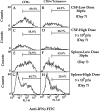Induction and exhaustion of lymphocytic choriomeningitis virus-specific cytotoxic T lymphocytes visualized using soluble tetrameric major histocompatibility complex class I-peptide complexes
- PMID: 9565631
- PMCID: PMC2212278
- DOI: 10.1084/jem.187.9.1383
Induction and exhaustion of lymphocytic choriomeningitis virus-specific cytotoxic T lymphocytes visualized using soluble tetrameric major histocompatibility complex class I-peptide complexes
Abstract
This study describes the construction of soluble major histocompatibility complexes consisting of the mouse class I molecule, H-2Db, chemically biotinylated beta2 microglobulin and a peptide epitope derived from the glycoprotein (GP; amino acids 33-41) of lymphocytic choriomeningitis virus (LCMV). Tetrameric class I complexes, which were produced by mixing the class I complexes with phycoerythrin-labeled neutravidin, permitted direct analysis of virus-specific cytotoxic T lymphocytes (CTLs) by flow cytometry. This technique was validated by (a) staining CD8+ cells in the spleens of transgenic mice that express a T cell receptor (TCR) specific for H-2Db in association with peptide GP33-41, and (b) by staining virus-specific CTLs in the cerebrospinal fluid of C57BL/6 (B6) mice that had been infected intracranially with LCMV-DOCILE. Staining of spleen cells isolated from B6 mice revealed that up to 40% of CD8(+) T cells were GP33 tetramer+ during the initial phase of LCMV infection. In contrast, GP33 tetramers did not stain CD8+ T cells isolated from the spleens of B6 mice that had been infected 2 mo previously with LCMV above the background levels found in naive mice. The fate of virus-specific CTLs was analyzed during the acute phase of infection in mice challenged both intracranially and intravenously with a high or low dose of LCMV-DOCILE. The results of the study show that the outcome of infection by LCMV is determined by antigen load alone. Furthermore, the data indicate that deletion of virus-specific CTLs in the presence of excessive antigen is preceded by TCR downregulation and is dependent upon perforin.
Figures












References
-
- Zinkernagel RM, Doherty PC. Restriction of in vitroT cell mediated cytotoxicity in lymphocytic choriomeningitis within a syngeneic or semiallogeneic system. Nature. 1974;248:701–702. - PubMed
-
- Townsend A, Rothbard J, Gotch FM, Bahadur G, Wraith D, McMichael AJ. The epitopes of influenza nucleoprotein recognized by cytotoxic T lymphocytes can be defined with short synthetic peptides. Cell. 1986;44:959–968. - PubMed
-
- Morris AG, Lin YL, Askonas BA. Immune interferon release when a cloned cytotoxic T-cell line meets its correct influenza-infected target cell. Nature. 1982;295:150–152. - PubMed
-
- Kündig TM, Hengartner H, Zinkernagel RM. T cell dependent interferon gamma exerts an antiviral effect in the central nervous system but not in peripheral sold organs. J Immunol. 1993;150:2316–2321. - PubMed
-
- Ruby J, Ramshaw I. The antiviral activity of immune CD8+ T cells is dependent on interferon-gamma. Lymphokine Cytokine Res. 1992;10:353–358. - PubMed
Publication types
MeSH terms
Substances
LinkOut - more resources
Full Text Sources
Other Literature Sources
Molecular Biology Databases
Research Materials

